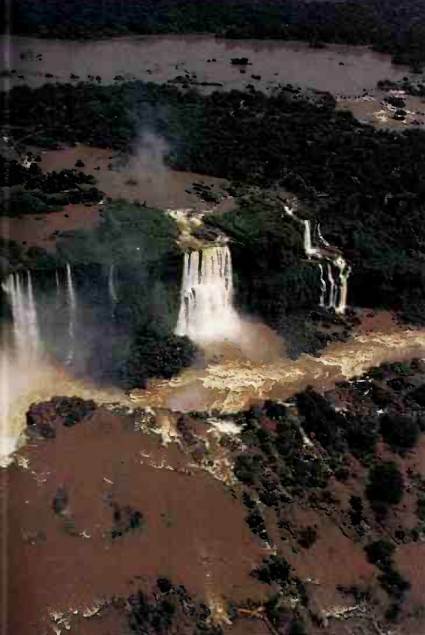Brazil. Environment. The Amazon Region. The Northeast Region. Central and Southern Plateaus
From the lush vegetation of the tropical rain forests to the arid Northeast and fertile Mato Grosso, Brazil's landscape is beautiful and dramatic. Because all but the southernmost part of Brazil lies in the tropics, the climate is warm to hot the year around, with plenty of rainfall.

Spectacular Iguacu Falls on the border between Brazil and Argentina is about 2 miles (3 kilometers) wide. The waters of some 30 rivers and streams plunge 237 feet (72 meters) down the cliffs in 275 separate waterfalls.
The Amazon Region. Extending across most of northern Brazil, the Amazon Region consists mostly of lowlands covered by jungle and tropical rain forest called selva. The region, which takes its name from the Amazon River that flows through it, also has two mountain areas—the Guiana Highlands in the far north and the Brazilian Highlands in the south.
The selva lies around the Amazon River and its tributaries, and it contains a tremendous variety of plant and animal life. More than 1, 500 kinds of birds and more than 40,000 varieties of plants live in the forests. Scientists have found over 3,000 kinds of trees in 1 square mile (1 .6 square kilometers) of the selva, and its animals include many kinds of monkeys as well as anteaters, jaguars, and sloths.

An Indian village, right, stands in a clearing of the dense Amazon forest in Xingu National Park. This protected area in norjhern Mato Grosso is home for many of Brazil's surviving lndian iribes
The climate in the western part of the Amazon Region is always hot and humid. Rain falls throughout the year, especially between December and May, for an annual total of about 160 inches (400 centimeters). The eastern part of the region receives less rain — about 40 to 80 inches (100 to 200 centimeters) annually.

Brazil's geography has strongly influenced the country's pattern of settlement. The hot, humid Amazon rain forest remains largely uninhabited, while the fertile soil and milder climate of southern Brazil have attracted most of the population.
The Northeast Region. The Northeast Region consists of the part of Brazil that juts out into the Atlantic Ocean. Although the region occupies less than one fifth of Brazil's total land area, about 30 per cent of its people live there—mainly on the coastal plains, where the fertile red soil drew the first Portuguese colonists to establish sugar cane plantations. Today, farmers still grow sugar cane, as well as cacao and tobacco.

The strong waves of the Atlantic, below, make the coast of Bahia a surfer's paradise. From the sandy white beaches of Rio de Janeiro to the peaceful bays and lagoons of Salvador, Brazil's coastline attracts tourists from all over the world.
Inland from the coastal plains lie the interior backlands, also known as the sertao. The sertao consists of plateaus and the hilly sections of the Brazilian Highlands. Agricultural production is low, due to the generally poor soil and the grazing land on the sertao and the variable rainfall, which may cause floods one year and droughts in another.
Central and Southern Plateaus. South of the Amazon Basin and the sertao lie the Central and Southern Plateaus, which include most of the Brazilian Highlands. A steep slope called the Great Escarpment runs along the Atlantic coast on the southeastern ridge of the highlands. This slope has been a partial barrier to the development of Brazil's interior.
The climate of the plateaus is cooler than the Amazon and Northeast regions. Winter frosts often occur in the state of Parana, and light snow sometimes falls in the state of Santa Catarina. More than half of Brazil's people live in the region of the Central and Southern Plateaus, known as the nation's economic heartland, because of its fertile soil, fine cattle ranches, and rich mines. Farmers grow coffee on large plantations called fazendas.

Fantastic rock formations, shaped by the wind and rain over thousands of years, are a feature of Vila Veiha Park, in the southern state of Parana. A human or animal form can be identified in most of the 23 different formations.
Date added: 2023-03-21; views: 742;
